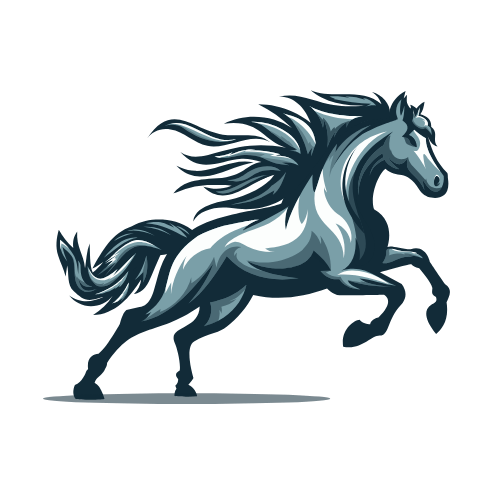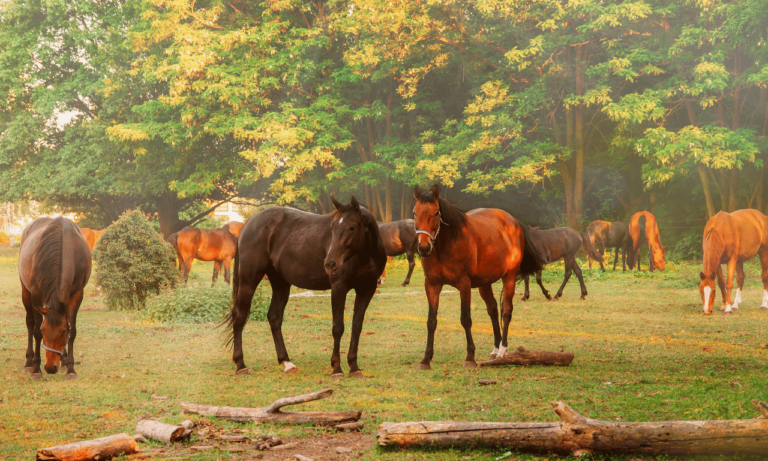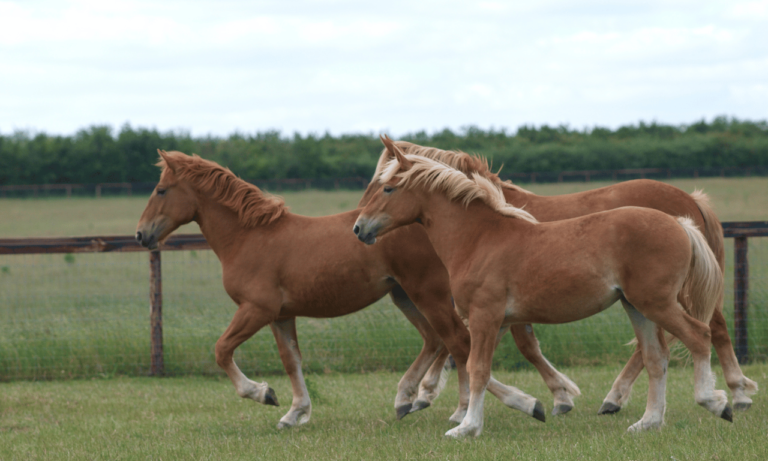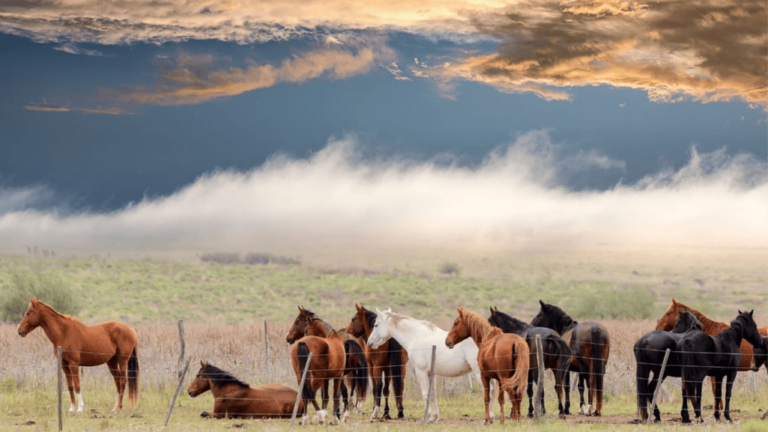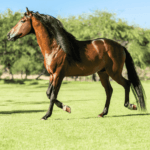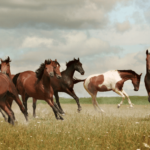Step into the world of thoroughbred horse racing, where the sound of hooves and the thrill of excitement meet. This sport highlights the incredible speed, agility, and grace of these amazing horses. They race on the world’s top tracks, showing off their skills.
The history of horse racing is rich and long, filled with tradition and new ideas. It focuses on breeding, training, and racing these horses. This makes the sport special and exciting.
Events like the Triple Crown and the Breeders’ Cup attract fans from everywhere. They love watching these horses run, feeling the excitement of the crowd. It’s a moment that touches the heart.
As you explore thoroughbred horse racing, you’ll see a deep connection between horses and riders. This bond is built on trust, skill, and a drive for excellence. It’s a world of beauty and power.
Thoroughbred racing changes the world of equestrian sports. It shows the strength and spirit of these animals and the people who care for them. Let thoroughbred horse racing take you on a journey that will touch your heart forever.
Key Takeaways
- Thoroughbred horse racing is a thrilling equestrian sport that showcases the speed, agility, and grace of equine athletes.
- The horse racing industry has a rich history and revolves around the breeding, training, and racing of thoroughbreds.
- Iconic tracks around the world host prestigious events like the Triple Crown races and the Breeders’ Cup.
- The bond between horse and jockey is forged through trust, skill, and a commitment to excellence.
- Thoroughbred racing transforms the equestrian sports landscape and captures the enduring spirit of these remarkable animals.
The Fascinating World of Thoroughbred Horses
Step into the captivating realm of thoroughbred horses. Here, beauty, power, and grace come together. These horses have captured the hearts of many for centuries. They are known for their sleek bodies and unmatched speed, making them stars of horse racing.
Thoroughbreds are unique athletes in the horse world. Their characteristics set them apart from other breeds. This makes them the ultimate competitors.
Exploring the Unique Characteristics of Thoroughbreds
Thoroughbred horses are known for their speed and agility. They are perfect for racing. Bred for over 300 years, they have the perfect mix of strength and speed.
They can run over 40 miles per hour. The fastest recorded speed is almost 44 miles per hour.
One interesting fact about thoroughbreds is their shared birthdate. They are officially one year older on January 1st, no matter when they were born. This makes tracking their age easier for racing events.
The Rich History and Heritage of Thoroughbred Racing
The history of thoroughbred racing is filled with legendary horses and dedicated breeders. The breed was developed through careful selective breeding in the 17th and 18th centuries. The English Jockey Club helped set the standards for racing, trying to keep non-English horses out.
Over time, some bloodlines have become famous in racing. About 95% of male thoroughbreds come from the Darley Arabian. These lines have produced many champion racehorses, enriching the sport’s history.
| Foundational Stallion | Origin | Influence on Thoroughbred Breed |
|---|---|---|
| Darley Arabian | Middle East | 95% of modern male thoroughbreds trace their lineage to this stallion |
| Godolphin Arabian | Middle East | Contributed significantly to the development of the thoroughbred breed |
| Byerley Turk | Middle East | One of the three foundational stallions that shaped the thoroughbred breed |
Thoroughbred horses are not just for racing. They excel in many equestrian disciplines. They are agile in polo, elegant in dressage, and strong in eventing. Their versatility makes them popular partners for riders worldwide.
“Thoroughbreds possess a unique combination of speed, endurance, and heart that sets them apart from other breeds. It’s no wonder they have captured the imagination of horse lovers for generations.”
– John Smith, renowned thoroughbred trainer
Thoroughbred horses have a big impact, beyond racing. Breeders and trainers work hard to bring out their best. The thoroughbred industry shows the strong bond between humans and horses. Each new generation of thoroughbreds continues a legacy that has shaped equestrian history, touching many hearts.
Breeding and Bloodlines: The Foundation of Thoroughbred Excellence
The heart of the Thoroughbred racing industry is selective breeding. It’s where the best bloodlines are made to create champion racehorses. For centuries, breeders have worked to improve equine genetics. They focus on traits like speed, stamina, and conformation to make the ultimate racehorse.
The Importance of Selective Breeding in Producing Champion Racehorses
Selective breeding is key to Thoroughbred excellence. Breeders pick the best stallions and mares to make great offspring. They understand horse genetics and look for the best traits in each generation.
When choosing breeding pairs, breeders look at many things. They consider:
- Pedigree and bloodlines
- Conformation and physical attributes
- Racing performance and accomplishments
- Temperament and disposition
By mixing these factors, breeders aim to create foals that are fast, enduring, and athletic. These are the qualities needed to win on the racetrack.
Famous Thoroughbred Bloodlines and Their Impact on the Sport
Some Thoroughbred bloodlines are legendary, producing many champions. These lines come from three foundation sires: the Darley Arabian, the Godolphin Arabian, and the Byerley Turk.
Some influential bloodlines include:
- Northern Dancer: Known for versatile and durable offspring.
- Secretariat: The 1973 Triple Crown winner, a dominant force in breeding.
- Mr. Prospector: Sire of many world-class racehorses.
- Sadler’s Wells: A European legend whose offspring won many classics.
These bloodlines have shaped Thoroughbred racing. Their influence is seen everywhere in the sport.
The Role of Stud Farms in Perpetuating Thoroughbred Lineages
Stud farms are crucial for keeping top Thoroughbred bloodlines alive. They focus on breeding and developing high-quality racehorses. This helps preserve the breed’s integrity.
At stud farms, top stallions get high stud fees. Breeders pay a lot to breed their mares to these stallions. For example, Fusaichi Pegasus, the 2000 Kentucky Derby winner, had a stud fee of around $200,000 per coupling.
| Stallion | Stud Fee (USD) | Notable Offspring |
|---|---|---|
| Galileo | $650,000 | Frankel, Australia, Minding |
| Tapit | $300,000 | Tonalist, Frosted, Constitution |
| War Front | $250,000 | Declaration of War, War of Will, U S Navy Flag |
The success of a stallion’s offspring affects their stud fees. For example, Seabiscuit’s wins made Hard Tack more popular, raising his stud fee from $250 to $1,000.
Stud farms manage breeding carefully. They pair only the best mares with top stallions. This ensures the sport of kings will thrive for many generations.
Training and Preparation: Molding a Thoroughbred Champion
The heart of a champion thoroughbred is amazing, weighing about 14 pounds on average. This powerful organ, along with lungs that move 50-75 liters of air per second, is the base for their incredible performances. To turn a thoroughbred into a champion, racehorse training and preparation are key.
Trainers use special methods to bring out each thoroughbred’s talents. They do equine performance evaluation and conformation assessment to find a horse’s strengths and weaknesses. This helps them tailor training to each horse’s abilities.
Consistency is crucial in training a racehorse. They follow regular exercise plans to improve strength, stamina, and speed. Trainers like Kelsey Gordon focus on drills that teach proper form and technique.
“The four-barrel drill is a foundational exercise in my training program. It helps teach green colts about momentum and consistent movement, while also correcting bad habits in seasoned horses.” – Kelsey Gordon
Nutrition is also vital for a champion thoroughbred. They need a diet rich in proteins, fats, vitamins, and minerals to perform well. Trainers work with nutritionists to create the best diet for each horse.
| Training Component | Key Elements |
|---|---|
| Equine Performance Evaluation | Speed capability, stamina, quick recovery |
| Conformation Assessment | Identifying strengths, weaknesses, and potential |
| Exercise Routines | Consistency, strength, stamina, speed |
| Specialized Drills | Four-barrel drill, promoting proper form and technique |
| Nutrition | High in proteins, fats, vitamins, and minerals |
As a thoroughbred trains, the focus shifts to perfecting racing strategies. Trainers help horses adapt to different racing environments. This prepares them for elite competitions.
The goal of training is to create a champion for events like the Kentucky Derby or the Breeders’ Cup Championships. Through hard work, expertise, and understanding each horse, trainers turn these animals into legends.
The Thrill of Thoroughbred Horse Racing: Major Events and Iconic Tracks
Thoroughbred horse racing is a sport that captivates audiences worldwide. It’s filled with excitement and shows off the amazing skills of horses. From the historic iconic racetracks to the prestigious events, it’s a world of tradition, passion, and unforgettable moments.
The Prestige and Excitement of the Triple Crown Races
The Triple Crown races are the top events in thoroughbred racing. They include the Kentucky Derby, Preakness Stakes, and Belmont Stakes. These races test the best of the best, with the Kentucky Derby being a beloved tradition since 1875.
The Kentucky Derby is famous for its mint juleps and festive atmosphere. It’s a celebration of the sport’s rich heritage. The Preakness Stakes and Belmont Stakes follow, with the Belmont being the longest race. Only 12 horses have won the Triple Crown, with legends like Secretariat and Affirmed.
Showcasing Thoroughbred Talent at Breeders’ Cup Championships
The Breeders’ Cup Championships bring together the world’s best thoroughbreds. They compete in various distances and surfaces. This event is a stage for champion racehorses to show their talent and heart.
With races like the Breeders’ Cup Classic, Turf, and Distaff, it’s a thrilling end to the racing season. It crowns the year’s standout performers.
Legendary Thoroughbred Racehorses and Their Unforgettable Performances
Some horses have left a lasting mark on thoroughbred racing. Secretariat, the most famous racehorse, swept the Triple Crown in 1973. His 31-length victory in the Belmont Stakes is unforgettable.
Other legendary racers like Man o’ War, Seabiscuit, and American Pharoah have also amazed fans. They show the power, grace, and determination of thoroughbred racing at its best.
| Triple Crown Race | Location | Distance | Notable Winners |
|---|---|---|---|
| Kentucky Derby | Churchill Downs, Louisville, Kentucky | 1 1/4 miles (2 km) | Secretariat (1973), Seattle Slew (1977), American Pharoah (2015) |
| Preakness Stakes | Pimlico Race Course, Baltimore, Maryland | 1 3/16 miles (1.9 km) | Citation (1948), Affirmed (1978), Justify (2018) |
| Belmont Stakes | Belmont Park, Elmont, New York | 1 1/2 miles (2.4 km) | War Admiral (1937), Whirlaway (1941), American Pharoah (2015) |
“A horse gallops with his lungs, perseveres with his heart, and wins with his character.” – Federico Tesio
The thrill of thoroughbred horse racing is more than just the excitement at the finish line. It’s about the stories of courage, determination, and partnership between horse and jockey. Fans become part of a timeless tradition that celebrates the spirit of the thoroughbred and the allure of the sport of kings.
Jockeys and Trainers: The Human Factors in Thoroughbred Success
Every champion thoroughbred racehorse has a dedicated team behind them. Jockeys and trainers play key roles in guiding these horses to victory. Their teamwork with the horses’ natural talents creates a powerful force on the race track. This combination of human skill and horse ability captivates audiences worldwide with their speed, agility, and heart.
The Skill and Strategy of Top Jockeys in Guiding Thoroughbreds to Victory
Jockeys are the unsung heroes of horse racing. Their expertise and quick decisions often decide the outcome of races. These athletes must know their horses well, adjusting their riding to bring out the best in each one.
From the start to the finish, jockeys use various tactics. They position themselves, control the pace, and encourage their horses to perform at their best.
“A great jockey becomes one with the horse, sensing its every move and responding instinctively to its needs. It’s a partnership built on trust, communication, and a shared desire to win.” – Hall of Fame Jockey, Mike Smith
The Expertise of Renowned Trainers in Developing Thoroughbred Potential
While jockeys get the glory on race day, trainers do the hard work behind the scenes. They create training plans that match each horse’s strengths and weaknesses. This builds the horse’s physical and mental strength over time.
Trainers use data to fine-tune their training. They look at things like how far the horse runs, how much rest it gets, and how intense the workouts are. This helps them improve performance and reduce injury risks.
| Training Factor | Optimal Range | Associated Benefits |
|---|---|---|
| Pre-trial galloping distance | 7,500 – 15,000 meters | Higher rate of career wins and previous season wins/places per start |
| Time between race starts | Up to 3 weeks | Greater rate of previous season wins and prizemoney per start |
| Frequency of rest breaks | Greater frequency | Greater prizemoney per start earned in the previous season |
Top trainers use their knowledge of horses to create champions. Their focus on detail and care for the horses’ well-being makes them stand out. They are the true architects of thoroughbred greatness.
In the world of thoroughbred racing, jockeys and trainers are key to success. Their skills and dedication turn promising horses into legends. As they continue to innovate, fans can expect even more thrilling races and unforgettable moments.
The Economic Impact and Global Reach of the Thoroughbred Industry
The thoroughbred horse racing industry is a global phenomenon. It generates substantial economic activity and supports a diverse array of businesses and livelihoods. With over half a million horses involved in racing worldwide, the industry offers an impressive €3.3 billion in prize money annually. In 2019 alone, the worldwide betting turnover exceeded a staggering €115 billion, highlighting the immense popularity and financial significance of the sport.
The United States, Australia, and Japan are among the leading players in the thoroughbred racing world. Each country has unique characteristics and economic contributions. In 2019, the USA hosted 36,066 races with 44,887 horses, averaging 6.1 starts per horse and 7.5 horses per race. The American betting turnover reached €9.8 billion, translating to €36,200 per race starter and €218,886 per horse.
Australia, with its vibrant racing culture, held 19,276 races featuring 34,939 horses. It averaged 5.2 starts per horse and 9.4 horses per race. The Australian betting turnover soared to €18.3 billion, with €100,706 per race starter and €522,463 per horse.
Japan, renowned for its passionate racing fans and high-stakes events, boasted the highest betting turnover at an astonishing €29.4 billion. With 16,444 races and 24,595 horses, Japan averaged 7.3 starts per horse and 10.9 horses per race. The betting turnover per race starter in Japan reached €164,425, while the turnover per horse amounted to €1,195,569, underlining the nation’s unwavering enthusiasm for the sport.
| Country | Races | Horses | Starts per Horse | Horses per Race | Betting Turnover | Turnover per Starter | Turnover per Horse |
|---|---|---|---|---|---|---|---|
| USA | 36,066 | 44,887 | 6.1 | 7.5 | €9.8 billion | €36,200 | €218,886 |
| Australia | 19,276 | 34,939 | 5.2 | 9.4 | €18.3 billion | €100,706 | €522,463 |
| Japan | 16,444 | 24,595 | 7.3 | 10.9 | €29.4 billion | €164,425 | €1,195,569 |
Beyond the racetrack, the thoroughbred industry encompasses a wide range of economic activities. This includes breeding, sales, and stud farm operations. Renowned thoroughbred auctions, such as the Keeneland Sales in the United States and Tattersalls in Europe, attract buyers from around the globe. These sales serve as crucial marketplaces for the exchange of premium bloodstock and the perpetuation of elite thoroughbred lineages.
Horse breeding farms and stud farm operations form the backbone of the industry. They meticulously select and nurture the next generation of champion racehorses. These enterprises invest heavily in state-of-the-art facilities, expert staff, and cutting-edge veterinary care to ensure the health, well-being, and performance potential of their equine athletes. The success of these breeding operations directly impacts the quality and competitiveness of the racing industry as a whole.
The global horse market size was valued at around USD 402.3 billion in 2022 and is projected to reach USD 793.9 billion by 2030, growing at a compound annual growth rate (CAGR) of 8.89%.
The thoroughbred racing industry’s economic impact extends far beyond the direct revenues generated by racing and breeding. It supports a vast network of ancillary businesses, including feed and equipment suppliers, veterinary services, transportation companies, and tourism operators. The industry also creates employment opportunities for jockeys, trainers, grooms, and other professionals dedicated to the care and training of these magnificent animals.
As the world becomes increasingly interconnected, the global reach of the thoroughbred industry continues to expand. International racing festivals, such as the Royal Ascot in England, the Prix de l’Arc de Triomphe in France, and the Dubai World Cup in the United Arab Emirates, showcase the sport’s global appeal. These events not only celebrate the thrill and glamour of thoroughbred racing but also serve as powerful economic drivers, attracting investment, tourism, and media attention.
In conclusion, the thoroughbred horse racing industry is a global economic powerhouse. It generates billions in revenue, supports countless jobs, and captivates audiences worldwide. From the thundering hooves on the racetrack to the meticulous breeding and training behind the scenes, every aspect of the industry contributes to its enduring success and global reach. As the sport continues to evolve and adapt to changing times, its economic impact and cultural significance remain as vital as ever, ensuring that the legacy of the thoroughbred will endure for generations to come.
Thoroughbred Horse Care and Welfare: Ensuring the Well-Being of Equine Athletes
The thoroughbred racing industry focuses on the highest care and welfare for its horses. From breeding to racing, their health is key. Veterinarians, trainers, and managers work hard to keep them healthy and happy.
The American Association of Equine Practitioners (AAEP) is crucial for racehorse welfare. Their 10-point plan aims to fix big issues and improve practices. It includes better treatments for common problems and stricter rules on medicines.
Proper Nutrition and Healthcare for Optimal Thoroughbred Performance
Knowing about horse anatomy and nutrition is vital for thoroughbred health. A balanced diet and regular vet checks keep them in top shape. Clean and comfy living spaces also help their well-being.
Keeneland leads in equine safety and welfare. They check each horse’s health, support injury research, and use new tech like StrideSAFE sensors. They also work on jockey safety and have a system for quick medical records in case of injuries.
| Initiative | Description |
|---|---|
| Prescription for Racing Reform | AAEP’s 10-point plan to safeguard racehorse health and welfare |
| EIPH Management | Developing non-race day treatment alternatives for exercise-induced pulmonary hemorrhage |
| Medication Regulations | Advocating for stricter limits on anabolic steroids and NSAIDs use |
| Equine Safety Team | Conducting thorough evaluations of each horse’s physical condition |
| StrideSAFE Sensors | Monitoring horse health and detecting potential issues |
Retirement and Second Careers for Thoroughbred Racehorses
Responsible owners and groups help thoroughbreds after racing. Many find new careers in dressage, eventing, or riding. Programs and adoptions help them transition to happy lives.
“The thoroughbred industry is united in its commitment to the welfare of these incredible equine athletes. By prioritizing their health, safety, and happiness, we not only do right by the horses but also safeguard the future of this beloved sport.”
The thoroughbred racing community works hard for horse welfare. Advances in nutrition, healthcare, and management help horses thrive. This ensures a caring environment for them on and off the track.
Technological Advancements in Thoroughbred Racing and Breeding
Technological advancements are changing thoroughbred racing and breeding. They improve performance, animal welfare, and competition. Tools like data analytics, biomechanics, genetic testing, and AI are making a big difference.
The Use of Data Analytics and Biomechanics in Enhancing Thoroughbred Performance
Data analytics and biomechanics are key to better thoroughbred performance. They help analyze a horse’s gait and stride. This info leads to better training and conditioning.
Biomechanics also helps spot injuries early. This means horses can avoid serious injuries. High-speed cameras and sensors help vets and trainers see small changes in movement.
Genetic Testing and Its Implications for Thoroughbred Breeding Decisions
Genetic testing is crucial in thoroughbred breeding. It shows the genetic potential of horses. This helps breeders choose the best stallions and mares.
It also helps avoid hereditary diseases. Breeders can pick breeding pairs that are healthier. This leads to stronger, more resilient thoroughbreds.
“Technological advancements have become the driving force behind enhanced performance, improved animal welfare, and increased industry competitiveness in thoroughbred racing and breeding.”
Technological advancements have a big impact on the thoroughbred industry. Here are some stats:
| Technological Advancement | Impact |
|---|---|
| AI-Powered Fertility Tracking | Significantly increases breeding success rates |
| Smart devices for horses | Monitor vital signs, activity levels, and sleep patterns, providing early health issue warnings |
| Remote consultations with veterinarians | Reduce stress on horses and improve access to expert care in rural areas |
| Disease prevention using technology | Focuses on early detection systems and outbreak prediction |
| Genetic screening | Helps prevent hereditary disease propagation |
The thoroughbred industry is excited about new tech. We’ll see AI in breeding, blockchain for traceability, and more. The future is bright with technology.
Conclusion: Embracing the Magnificence of Thoroughbred Horse Racing
Thoroughbred horse racing is a display of power, speed, and grace. It has a long history that has won fans worldwide. Every part of the sport, from the racing to the breeding, shows the hard work and love for it.
Legendary horses like Secretariat have amazed us with their speed. Events like the Arkansas Derby show what these horses can do. The sport’s popularity, even in tough times, shows its lasting appeal.
We must care for these amazing horses as we look to the future. By focusing on their health and celebrating their talents, we can keep the sport alive. Let’s work together to keep thoroughbred racing a beloved tradition for years to come.
